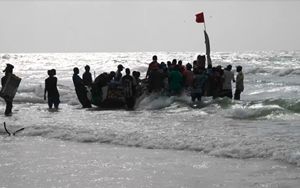(Finance) – On January 31, the English NGO Feedback released a report highlighting how Norwegian salmon producers (the main salmon producer in the world) would take away food resources from West African countries to produce feed for fish. According to the study estimates, in 2020 almost 2 million tons of wild fish perfectly edible would have been used to produce fish oil for Norwegian salmon feed and a good part of this fish came from West African countries, an area at risk of food security, where it could have fed between 2.5 and 4 million of people.
This discussion, however, It’s not just about Norwegian salmonbut it arises within a much broader question, that ofaquaculture, i.e. the breeding of water animals, known for being the fastest growing food industry in the world, so much so that already in 2021 globally the quantity of farmed fish produced exceeded fishing. Exact numbers, when it comes to fish, are practically impossible, but according to some estimates in the world Between 40 and 120 billion fish are farmedfor an annual production, according to the UN Food and Agriculture Organization, of approximately 122.6 million tonnes.
Is exactly Intensive fish farming is the theme of Francesco De Augustinis’ new documentary, Until the End of the World, third work by the director who has always investigated the link between intensive farming and sustainability and this time focuses on fish farming, in particular on the impact of the production of farmed sea bass, sea bream and salmon.
The documentary, the result of three years of journalistic research, created thanks to the support of Journalismfund.eu and Internews’ Earth Journalism Network, tells the various stages of a journey in the footsteps of the aquaculture industrya, to investigate whether this production model really contributes to making the food system more sustainable, as it promises, in the face of a world population that could reach 9.7 billion people in 2050.
The documentary explains how the exponential rise of aquaculture is not random, but the result of a precise political will linked to the idea of the “Blue Transformation”, the United Nations strategy to increase global food production with greater use to marine resources. In fact, however, explains the documentary, this unconditional support for the farming of salmon, sea bass, sea bream and other fish, today it is attracting huge investments to this relatively new industry, which is consequently growing dramatically in various regions of the world. The film also shows the side effects of this exponential growth, which is very reminiscent of what happened a few decades ago with the birth and spread of intensive land farming everywhere.
Starting from the sea bass and sea bream farms in the Mediterranean, in Italy, Greece and Spain, the documentary shows the pollution of natural paradises, the destruction of small local economies and the paradoxical competition of this industry with the livelihoods of entire communities, even in vulnerable areas of the planet. “The idea of the documentary is to tell and connect the stories of different communities that in different parts of the world are fighting against the expansion of fish farming”, he says De Augustinis. “From Italy, to Greece, from Spain to Senegal, up to the once pristine waters of Chilean Patagonia, the film tells of a perennial conflict for resources linked to the enormous growth of this industry.” The picture that emerges is very reminiscent of a certain form of ‘colonialism’, a word that recurs for different reasons in many parts of the film. In fact, the documentary shows how this industry depends on the capture of natural resources, whether they are portions of the sea to be transformed into productive areas or enormous quantities of fish to be transformed into feed.
Excessive dependence on fishing, in a scenario where more than half of marine species are already fished above safe levels, is pushing the industry to look for “new solutions” to produce feed and feed an ever-increasing number of fish in farms . The story of one of these alternative solutions leads the viewer, in the last part of the documentary, “to the end of the world”, among the icy waters surrounding Antarctica. This is one of the most symbolic places on the planet, whose survival today is seriously called into question by climate change. But Antarctica, we will discover, also has to contend with the relentless search for raw materials to feed the unabated growth of the fish farming industry.
